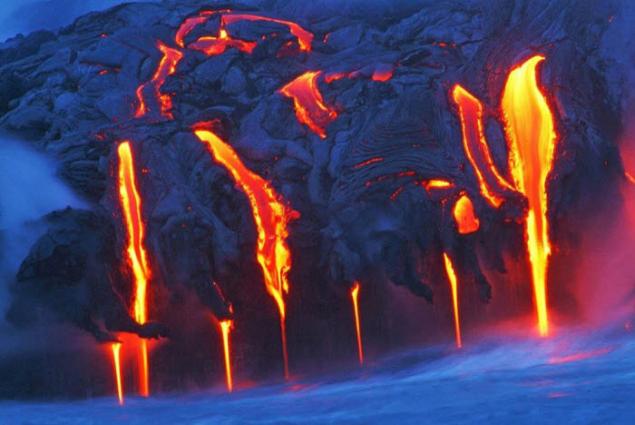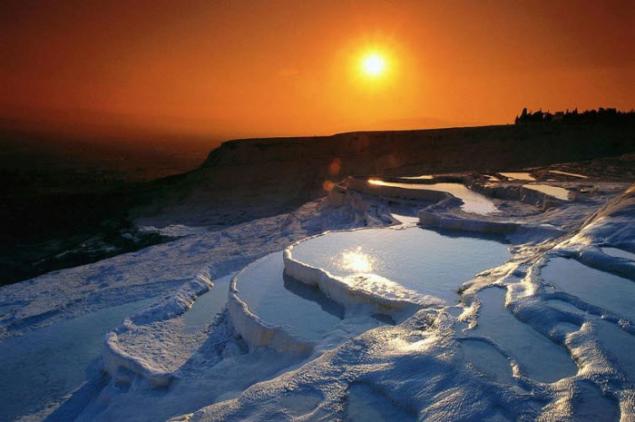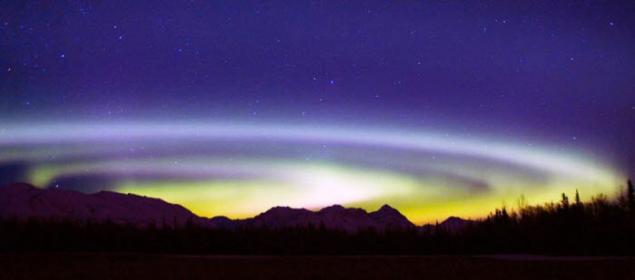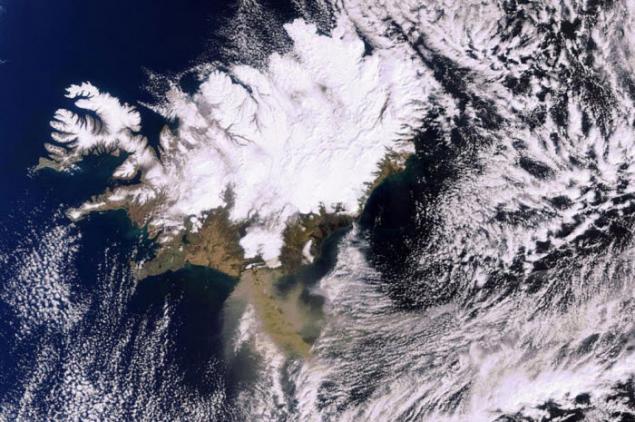2763
Our planet (20 photos)
Plains, deserts, volcanoes, canyons, tropical forests and other natural wonders.


1. Rock Uluru, also known as Ayers Rock. One of the oldest rocks in the world. It was formed over 500 million years ago, and there, when the sand was going on the ocean floor, which once covered the middle part of Australia. For years, the wind and the rain fell upon the rock. Now the flat summit rises 348 meters above the plains, and the base of the cliff stretches for 8 km. This rock is known that during the day changes its color. Above: At dawn and dusk rock is painted in dark red color. On the color affects the angle of incidence of sunlight. Rays of light coming through the atmosphere, the blue light is distorted, leaving a red, which makes Uluru shine red. Another factor affecting the color change: the area around Ayers Rock is flat, and as soon as the sun dives into the horizon, the area is in the shade, but the sunlight still reaches the rock. This contrast of dark and light stone foundation make Ayers Rock turns red. Bottom: rock, which is usually red in color, is shown in this photo after the rain, which is a rarity here. During the rainy season the rock acquires a silvery-gray color, with stripes of dark algae forming on the path of rain runoff streams. The difference in color on these two photos is amazing. (Steve Strike, AP)

2. Grand Prismatic Spring in Yellowstone National Park, Wyoming. Grand Prismatic Spring - the largest hot spring in the United States and the third largest in the world - after those who are in New Zealand. He is located in the middle basin geysers. Source size of about 75 to 91 m, and depth - 48 meters. Source produces about 2120 liters per minute, water temperature - 71 degrees Celsius. Bright colors source - is the result of life pigmented bacteria present on the edges of source water rich in minerals. In the photo: Tourists go on deck at the Grand Prismatic Spring. (Yann Arthus-Bertrand, Harry N. Abrams, Inc. / AP)

3. Lava from Kilauea Volcano in Hawaii flows into the Pacific Ocean at dawn on July 1 in Vulcano. Thousands of visitors to the park come here every day to look at the Kilauea eruption, which lasted for a quarter century. But some people live near the boiling lava every day. (David Jordan, AP)

4. Pamukkale, Turkey. Pamukkale - unusual natural and historical site with brilliant cascades of water. This is one of the main attractions of Turkey. Turkish word "Pamukkale" means "cotton castle". Dazzling white terraces (travertine formation) appeared on the hillside in the deposition of calcium salts of saturated sources. Pamukkale water famous for its healing effects on the eyes and skin. Air Pamukkale useful to patients with asthma, rheumatism. (Michele Burgess, Corbis)

5. Antarctica. Gentoo penguins (left) stand with chinstrap penguins on a drifting ice floe in the Southern Ocean Antarctic Peninsula. (Scott Canon, Kansas City Star / MCT)

6. Great Barrier Reef. Great Barrier Reef - the largest coral reef system in the world, consisting of 2,900 individual reefs and 900 islands stretching over a distance of 2574 km. The reef is located in the Coral Sea, off the coast of Queensland in northeast Australia. Large coral reef can be seen from outer space. It is the largest single structure created from living organisms. In 1981, this place has become a world heritage site. It is considered one of the seven modern wonders of the world. (Queensland Tourism, HO / AP)

7. Ngorongoro Crater. Ngorongoro Crater - the largest whole, unflooded volcanic caldera. Crater formed by the collapse of a large volcano is about 2, 5 million years ago, is in the depth of 600 meters, and its bottom covers an area of 26,400 hectares. The bottom of the crater is located at an altitude of 2380 m above sea level. Its edges are approximately 600 m above and rise to 3000 m above sea level. In the photo: a herd of zebras walking in salt lake Magadi in the Ngorongoro Crater, Tanzania. (Tim Graham, Getty Images)

8. Victoria Falls. Victoria Falls over 1800 meters wide, making it the largest in the world. Water drops from a height of 89 - 106 meters. The waterfall is located approximately in the middle of the river Zambezi.

9. Himalayas. Himalayas, or "bulwark of snow" - mountain range in Asia, consisting of a continuous line length of about 2574 km along the northern edge of the Indian subcontinent, from the bend of the Indus River in the northwest of the river Brahmaputra in the east. The system of the Himalayas (in an average width of 350 km) rises on the Gangetic plain. Himalayas - the highest mountain system of the Earth, consisting of the 10 highest peaks in the world. The highest among them - Everest (8,848 meters), which is on the Nepal-Tibet border. The second highest peak - Chogori (8611 meters) - is located on the border of China, Jammu and Kashmir, and the third - Kanchenjunga (8586 m) - is located on the border of Nepal and India. Photo: Tsho Rolpa lake in the Himalayas. (Macduff Everton, Corbis)

10. Aurora. North (or South, depending on the hemisphere) shine - this is caused by the bombing of the upper atmosphere by charged particles moving to the land along the geomagnetic field lines of the adjacent space, called plasma layer. Usually it occurs in the ionosphere. In the collision of energetic particles of the plasma layer with the upper atmosphere is excited atoms and molecules of the gases entering into its composition. Radiation of excited atoms in the visible range and is observed as the aurora. Aurora borealis most often occurs from September to October and from March to April. This glow came over the river Talkeetna, near Palmer, Alaska. (Bob Martinson, AP)

11. Volcano. In this picture, taken from the satellite on April 17 visible plume of volcanic ash and smoke from the volcano Eyjafjallajökull in Iceland. (HO, AFP / Getty Images)

12. Iguazu Falls. Complex Iguazu Falls has a width of 2, 7 km and includes approximately 270 separate waterfalls, arranged in a horseshoe. Many islands (including quite large) are separated from each other waterfalls. One of the most famous - "Devil's Throat", part of which is visible in this photo. (Juan Mabromata, AFP / Getty Images)

13. Migration of wildebeest in the Serengeti. A herd of wildebeest gathered on a hilltop at sunset after successfully crossing the river Mara during annual migration through the Masai Mara National Park in Kenya, 15 August 2008. In the Serengeti - the largest migration of wildebeest. Wildebeest - herbivores, they are constantly moving from place to place in search of water and grass. During a cycle of migration of wildebeest are 800 - 1600 km each year immediately after calving period in January - February. They move from the south-east of the Serengeti plains to the west, to Lake Victoria, and then turn north to the Masai Mara. Many get damaged, and the weaker or simply die young. By the end of the dry season wildebeest almost completely emptied and returned to the pasture to the south for the rainy season. (Roberto Schmidt, AFP / Getty Images)

14. Galapagos. A flock of pelicans flying over the frigates on the islands of San Cristobal in the Galapagos archipelago. (Ricardo Mazalan, File / AP)

15. The stalactites and stalagmites. Stalactites and stalagmites - conical formation in caves. This calcium deposits formed by dripping water from the ceiling to the floor of the cave. They look like large icicles. Water evaporates in the caverns, leaving calcium. These calcium deposits are formed in two ways: stalactite - from top to bottom, stalagmite - from the bottom up. (Corbis)

16. Rainbow. Rainbow - is atmospheric optical and meteorological phenomenon that is observed usually after rain or in front of him. Rainbow arises from the fact that sunlight undergoes refraction in water droplets of rain or mist hovering in the atmosphere. Rainbow takes the form of multi-colored arc with red on the outside and purple inside. The most magnificent rainbow appears when half of the sky is still dark with clouds, and the one who looks at a rainbow, standing under a clear sky.

17. The Amazon rainforest. Amazon rainforest - one of the largest natural resources. Forest vegetation constantly recycles carbon monoxide into oxygen. This forest - the lungs of our planet. Amazon rainforest produces 20% oxygen. In this photo visible thick jungle, as well as the process of deforestation in June 2008 in Manaus, Brazil. Forests in the Amazon - the largest tropical forest in the world. They occupy half of the total area of remaining tropical forests on the planet. (Per-Anders Pettersson, Getty Images)

18. Lake Sandoval. Lake Sandoval is in a protected nature reserve in the Peruvian Tambopata rainforest of South Africa. (Tim Graham, Getty Images)

19. Grand Canyon. Grand Canyon - one of the deepest canyons in the world, cut by the Colorado River in Arizona, USA. It is located in the National Park Grand Canyon - it was one of the first national parks in the United States. Researchers concluded that the Grand Canyon was formed by the Colorado River over 6 million years ago. The length of the canyon - 446 km, width - from 6 to 29 km. Depth reaches 1,600 meters.


1. Rock Uluru, also known as Ayers Rock. One of the oldest rocks in the world. It was formed over 500 million years ago, and there, when the sand was going on the ocean floor, which once covered the middle part of Australia. For years, the wind and the rain fell upon the rock. Now the flat summit rises 348 meters above the plains, and the base of the cliff stretches for 8 km. This rock is known that during the day changes its color. Above: At dawn and dusk rock is painted in dark red color. On the color affects the angle of incidence of sunlight. Rays of light coming through the atmosphere, the blue light is distorted, leaving a red, which makes Uluru shine red. Another factor affecting the color change: the area around Ayers Rock is flat, and as soon as the sun dives into the horizon, the area is in the shade, but the sunlight still reaches the rock. This contrast of dark and light stone foundation make Ayers Rock turns red. Bottom: rock, which is usually red in color, is shown in this photo after the rain, which is a rarity here. During the rainy season the rock acquires a silvery-gray color, with stripes of dark algae forming on the path of rain runoff streams. The difference in color on these two photos is amazing. (Steve Strike, AP)

2. Grand Prismatic Spring in Yellowstone National Park, Wyoming. Grand Prismatic Spring - the largest hot spring in the United States and the third largest in the world - after those who are in New Zealand. He is located in the middle basin geysers. Source size of about 75 to 91 m, and depth - 48 meters. Source produces about 2120 liters per minute, water temperature - 71 degrees Celsius. Bright colors source - is the result of life pigmented bacteria present on the edges of source water rich in minerals. In the photo: Tourists go on deck at the Grand Prismatic Spring. (Yann Arthus-Bertrand, Harry N. Abrams, Inc. / AP)

3. Lava from Kilauea Volcano in Hawaii flows into the Pacific Ocean at dawn on July 1 in Vulcano. Thousands of visitors to the park come here every day to look at the Kilauea eruption, which lasted for a quarter century. But some people live near the boiling lava every day. (David Jordan, AP)

4. Pamukkale, Turkey. Pamukkale - unusual natural and historical site with brilliant cascades of water. This is one of the main attractions of Turkey. Turkish word "Pamukkale" means "cotton castle". Dazzling white terraces (travertine formation) appeared on the hillside in the deposition of calcium salts of saturated sources. Pamukkale water famous for its healing effects on the eyes and skin. Air Pamukkale useful to patients with asthma, rheumatism. (Michele Burgess, Corbis)

5. Antarctica. Gentoo penguins (left) stand with chinstrap penguins on a drifting ice floe in the Southern Ocean Antarctic Peninsula. (Scott Canon, Kansas City Star / MCT)

6. Great Barrier Reef. Great Barrier Reef - the largest coral reef system in the world, consisting of 2,900 individual reefs and 900 islands stretching over a distance of 2574 km. The reef is located in the Coral Sea, off the coast of Queensland in northeast Australia. Large coral reef can be seen from outer space. It is the largest single structure created from living organisms. In 1981, this place has become a world heritage site. It is considered one of the seven modern wonders of the world. (Queensland Tourism, HO / AP)

7. Ngorongoro Crater. Ngorongoro Crater - the largest whole, unflooded volcanic caldera. Crater formed by the collapse of a large volcano is about 2, 5 million years ago, is in the depth of 600 meters, and its bottom covers an area of 26,400 hectares. The bottom of the crater is located at an altitude of 2380 m above sea level. Its edges are approximately 600 m above and rise to 3000 m above sea level. In the photo: a herd of zebras walking in salt lake Magadi in the Ngorongoro Crater, Tanzania. (Tim Graham, Getty Images)

8. Victoria Falls. Victoria Falls over 1800 meters wide, making it the largest in the world. Water drops from a height of 89 - 106 meters. The waterfall is located approximately in the middle of the river Zambezi.

9. Himalayas. Himalayas, or "bulwark of snow" - mountain range in Asia, consisting of a continuous line length of about 2574 km along the northern edge of the Indian subcontinent, from the bend of the Indus River in the northwest of the river Brahmaputra in the east. The system of the Himalayas (in an average width of 350 km) rises on the Gangetic plain. Himalayas - the highest mountain system of the Earth, consisting of the 10 highest peaks in the world. The highest among them - Everest (8,848 meters), which is on the Nepal-Tibet border. The second highest peak - Chogori (8611 meters) - is located on the border of China, Jammu and Kashmir, and the third - Kanchenjunga (8586 m) - is located on the border of Nepal and India. Photo: Tsho Rolpa lake in the Himalayas. (Macduff Everton, Corbis)

10. Aurora. North (or South, depending on the hemisphere) shine - this is caused by the bombing of the upper atmosphere by charged particles moving to the land along the geomagnetic field lines of the adjacent space, called plasma layer. Usually it occurs in the ionosphere. In the collision of energetic particles of the plasma layer with the upper atmosphere is excited atoms and molecules of the gases entering into its composition. Radiation of excited atoms in the visible range and is observed as the aurora. Aurora borealis most often occurs from September to October and from March to April. This glow came over the river Talkeetna, near Palmer, Alaska. (Bob Martinson, AP)

11. Volcano. In this picture, taken from the satellite on April 17 visible plume of volcanic ash and smoke from the volcano Eyjafjallajökull in Iceland. (HO, AFP / Getty Images)

12. Iguazu Falls. Complex Iguazu Falls has a width of 2, 7 km and includes approximately 270 separate waterfalls, arranged in a horseshoe. Many islands (including quite large) are separated from each other waterfalls. One of the most famous - "Devil's Throat", part of which is visible in this photo. (Juan Mabromata, AFP / Getty Images)

13. Migration of wildebeest in the Serengeti. A herd of wildebeest gathered on a hilltop at sunset after successfully crossing the river Mara during annual migration through the Masai Mara National Park in Kenya, 15 August 2008. In the Serengeti - the largest migration of wildebeest. Wildebeest - herbivores, they are constantly moving from place to place in search of water and grass. During a cycle of migration of wildebeest are 800 - 1600 km each year immediately after calving period in January - February. They move from the south-east of the Serengeti plains to the west, to Lake Victoria, and then turn north to the Masai Mara. Many get damaged, and the weaker or simply die young. By the end of the dry season wildebeest almost completely emptied and returned to the pasture to the south for the rainy season. (Roberto Schmidt, AFP / Getty Images)

14. Galapagos. A flock of pelicans flying over the frigates on the islands of San Cristobal in the Galapagos archipelago. (Ricardo Mazalan, File / AP)

15. The stalactites and stalagmites. Stalactites and stalagmites - conical formation in caves. This calcium deposits formed by dripping water from the ceiling to the floor of the cave. They look like large icicles. Water evaporates in the caverns, leaving calcium. These calcium deposits are formed in two ways: stalactite - from top to bottom, stalagmite - from the bottom up. (Corbis)

16. Rainbow. Rainbow - is atmospheric optical and meteorological phenomenon that is observed usually after rain or in front of him. Rainbow arises from the fact that sunlight undergoes refraction in water droplets of rain or mist hovering in the atmosphere. Rainbow takes the form of multi-colored arc with red on the outside and purple inside. The most magnificent rainbow appears when half of the sky is still dark with clouds, and the one who looks at a rainbow, standing under a clear sky.

17. The Amazon rainforest. Amazon rainforest - one of the largest natural resources. Forest vegetation constantly recycles carbon monoxide into oxygen. This forest - the lungs of our planet. Amazon rainforest produces 20% oxygen. In this photo visible thick jungle, as well as the process of deforestation in June 2008 in Manaus, Brazil. Forests in the Amazon - the largest tropical forest in the world. They occupy half of the total area of remaining tropical forests on the planet. (Per-Anders Pettersson, Getty Images)

18. Lake Sandoval. Lake Sandoval is in a protected nature reserve in the Peruvian Tambopata rainforest of South Africa. (Tim Graham, Getty Images)

19. Grand Canyon. Grand Canyon - one of the deepest canyons in the world, cut by the Colorado River in Arizona, USA. It is located in the National Park Grand Canyon - it was one of the first national parks in the United States. Researchers concluded that the Grand Canyon was formed by the Colorado River over 6 million years ago. The length of the canyon - 446 km, width - from 6 to 29 km. Depth reaches 1,600 meters.
























